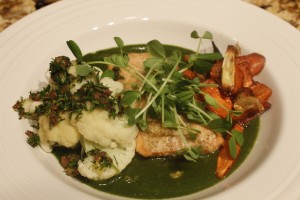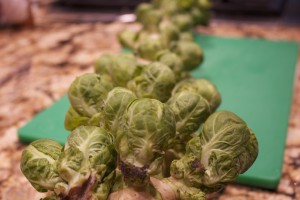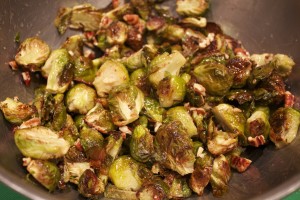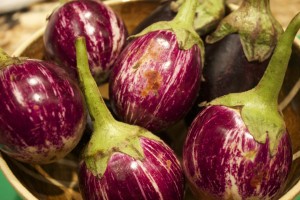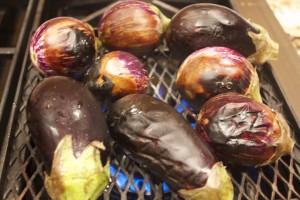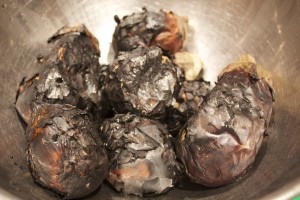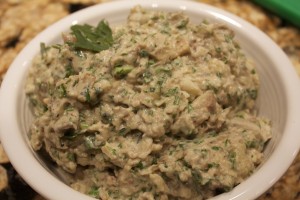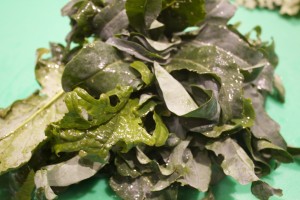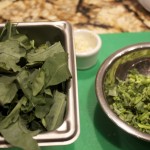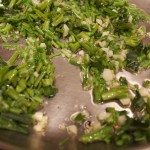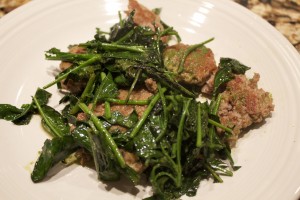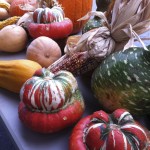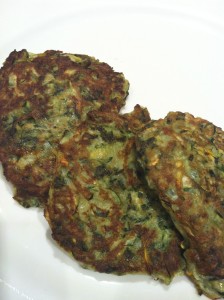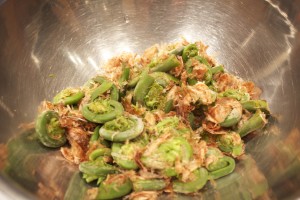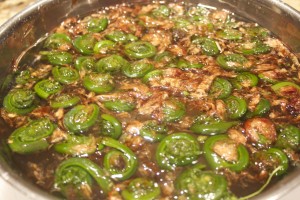
|
Sunday Night Dinner Sunday night was a night for using up those bits and pieces in the refrigerator and freezer. I had some wild salmon from Alaska ready to use that I had defrosted, as well as some toasted fennel seed vinaigrette. I keep a stash of homemade stocks in my freezer: roasted vegetable stock; chicken, fish, lamb, and beef bone broths, so I had instant flavor available to enliven my meal. I defrosted a small bit of vegetable stock. I added the Swiss chard in a small pot with ½ cup or so of vegetable stock, puréed the whole mix, and finished it with a pat of butter. I tossed the salmon in the fennel seed vinaigrette and then baked it at 375˚F. for about 15 minutes, until just pink in the middle. I mixed the sliced carrots and parsnips with a couple tablespoons stock, a couple tablespoons extra virgin olive oil, a pinch cinnamon, nutmeg, cayenne, salt and pepper. I nestled some garlic slices among the vegetables as well. I baked them covered until tender, about 20 minutes, then uncovered them for another 10 minutes until the carrots and parsnips browned. I steamed the cauliflower then sprinkled it with a mix of lemon zest, parsley, and chopped kalamata olives. I served the salmon, cauliflower, and carrot mix on top of the chard puree and tossed some pea shoots in the middle. Share on Facebook and Twitter | Dinner, Greens, ingredients, Recipes, Vegetables | No comments
Seasonal Vegetable Dishes from Union Square Greenmarket Last week was beautiful at the Union Square greenmarket. The whole stalks of Brussel Sprouts were too enticing to resist, so I bought a whole stalk. I’m not the only ones enamored with snapping off the the nuggets from the stalk. Over the weekend, the little nephews had a wonderful time snapping off the sprouts as well. I halved the stalks, tossed them with extra virgin olive oil and salt, and roasted them at 375˚ for 20 minutes. Meanwhile, I made a quick glaze of maple syrup, mustard, and butter that I heated on the stove. I tossed the Brussels sprouts with this mix and sprinkled the whole lot with chopped pecans. It’s nearing the end of eggplant season as well, so I purchased these miniature varieties and roasted them on the my chile grate (these grates are wonderful for roasting multiple vegetables at once.) I like the chile grate especially for small chiles and eggplants, since they don’t fall into the open flame. The smokey flavor of eggplants cooked directly over the fire is irresistible. After I covered them and let them cool a bit, I scraped off the skin, chopped the flesh, and mixed them with tahini, lemon juice, garlic, parsley, and pomegranate molasses. I served the chunky dip on rye bread from Rui’s, a fairly new Friday and Saturday Union Square Greenmarket addition. These guys make traditional hearty, delicious Scandinavian (100 per cent) rye bread. I also picked up an interesting vegetable called spigariella. It actually is a kind of broccoli without florettes, and tastes like a sweeter version of broccoli raab. It cooks in just minutes. I cut off the stems and cooked them first with garlic, olive oil, and red pepper flakes.
Share on Facebook and Twitter | Greenmarket Bits, Greens, ingredients, Side Dishes, Vegetables | No comments
Getting the Water out of a Zucchini I’m on a market watch – greenmarket watch that is. Several times a week, I walk through my neighborhood farmer’s market and survey the new arrivals and take notice of what is no longer available. This journey is how I keep up with the changes in seasonal produce, and it’s how I stay inspired in my cooking. In early summer, local markets are brimming with delicious produce; even an average supermarket has a broader than usual selection of colorful vegetables and fruits. It’s still worth going out of your way to a venue where you can speak to the growers. The abundance and variety of eatables, the enthusiasm of the farmers, and the excitement of happy people shopping prompt me to load up my cart with local delights, and pile my dinner plate with a variety of fresh vegetables.
In a farmer’s market from July though October, besides the green zucchini, you can purchase the bright daffodil-yellow ones as well. Summer squash come in a wide variety of shapes and sizes – from round eight balls to yellow- and-green zephyr squashes, ruffle-edged patty pans to ridged romanescos. Even though summer squashes come in a variety of shapes and sizes, you can use them interchangeably in recipes. All varieties tend to be watery. If you want to coax the most flavor out of summer squashes, it’s best to get rid of a lot of that water. After all, few delight in a soggy squash dish. I use salt to extract the excess moisture. To sauté a pound of sliced zucchini, sprinkle about a teaspoon of salt over the pieces and let them rest for 20 minutes to half an hour. You’ll notice the zucchini start to sweat and glisten. Wipe off the surface moisture with a paper towel – which gets rid of the excess salt – and now you’re ready to sauté. Your slices will caramelize beautifully, leaving a golden color and rich flavor. The salting technique is especially effective with grated zucchini. For each pound, mix in 1 teaspoon salt. After about twenty minutes, grab a handful at a time of the grated vegetable and start squeezing – over a bowl, of course. I’m always amazed at just how much water comes pouring out. After you’ve gone through the first round, go back and squeeze the whole lot one more time. Again, any excess salt gets squeezed out with the water, and your grated zucchini is ready to be turned into delicious pancakes, fritatas, or whatever else you’re cooking. Share on Facebook and Twitter | Greenmarket Bits, Kitchen Tips, Vegetables | No comments
Fiddlehead Ferns Last week I noticed the first fiddlehead ferns at the Union Square greenmarket. I couldn’t resist purchasing them. Fiddleheads epitomize spring at its most fleeting – they are available a mere three to four weeks locally. If you want to play with these furled fronds, get them soon; consider a visit to a local market at least in the next two weeks, or you’ll be too late and will have to wait until next year. The ferns actually started showing up in Whole Foods a few weeks earlier than they did at the greenmarket; the ones at Whole Foods are are probably imported from Maine, since those have a bit of a longer season, lasting from April through May. Fiddleheads are from the Ostrich fern, and have a brown papery scaly covering (they remind me of bonito flakes) the uncoiled fern. The ostrich fern is a wild food found in wet areas: on the banks of river, steams, and brooks. Their flavor is a cross between that of asparagus and artichoke. For my preparation, I soaked these in water to dislodge the papery coverings. Honestly, I never did see ferns with the coverings before this year, and I’ve been cooking these delicate scrolls for years. The coverings made these specimens seem fresher and just-foraged. Make sure to pick off any papery bits that don’t dislodge in the water (this job is a bit “fiddly”), then steam or boil the ferns before cooking or dressing further. I paired these babies with smoked mackerel, sautéed red onions and slivered ramps for a delicious breakfast this week. Viva la primavera! Share on Facebook and Twitter | Breakfast, Greenmarket Bits, ingredients, Vegetables | No comments
|
